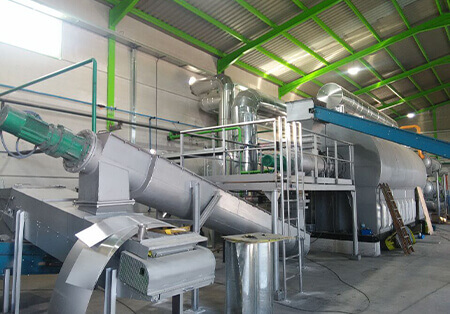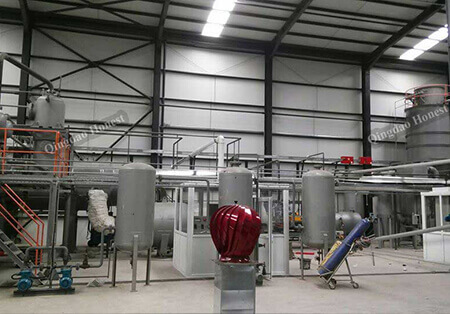
Wondering where waste management heads next? Pyrolysis technology sits at the forefront. It turns trash into treasure—fuel, carbon, and more—without the mess of burning. As we hit 2025, this field buzzes with change. New reactors, smarter systems, and green integrations promise big shifts. If you run a recycling firm or handle industrial waste, these developments could cut costs and boost your bottom line. We’ll explore what’s coming, backed by real-world examples and market trends. Stick with us to see how pyrolysis evolves.
Pyrolysis breaks down organic materials with heat, no oxygen involved. Think waste tires or plastics heated in a sealed chamber. Out come oil, gas, and solids like carbon black. Right now, it’s key for handling tough waste. In China, many companies are in the leading position
Challenges persist. Efficiency varies, and scaling up costs money. But applications grow. Biomass turns to bio-oil for fuels. Plastics become synthetic oils, cutting landfill use. Waste-to-energy setups reduce emissions compared to incineration. Globally, plastic waste hits billions of tons yearly. Only 9% gets recycled. Pyrolysis fills that gap, especially for mixed materials.
Look at market stats. The pyrolysis equipment sector valued at $5.4 billion in 2023 heads to $10.3 billion by 2032, growing 8.3% yearly. Oil from pyrolysis? It reached $360 million in 2024, eyeing 4.2% growth to 2032. These numbers show demand rising, driven by sustainability pushes.
Reactors form the heart of pyrolysis. Traditional rotary kilns work fine but lack speed. Enter advanced types.
These use microwaves for direct heating. Faster times, better yields. Energy drops 20-30% versus old methods. Precise control means consistent bio-oil. Ideal for small ops, like community waste sites.
High-energy plasma zaps materials at extreme temps. Handles tricky stuff—medical waste, contaminated plastics. Clean fuels emerge, with minimal residue. Though costly now, prices fall as tech matures.
Portable setups shine for remote areas. Deploy to farms or disaster zones. Process waste on-site, no transport hassles.
Innovations here boost efficiency. Better catalysts hike yields by 10-15%. Reactor tweaks handle diverse feeds. By 2025, expect widespread adoption in urban recycling.
Pyrolysis pairs well with clean energy. No more fossil fuels for heating.
Solar thermal integrates directly. Sun heats reactors in sunny spots. Cuts reliance on grids. Projects like Pysolo combine concentrated solar with pyrolysis for carbon-neutral runs.
Syngas from the process feeds fuel cells. Generates power on-site. Waste becomes electricity and heat. In 2025, this hybrid approach grows, especially in off-grid areas.
Carbon capture adds value. Biochar sequesters CO2 in soil. With climate goals tightening, this earns credits. Overall, renewables make pyrolysis carbon-negative in some cases.
Early pyrolysis stuck to basics. Now, it expands.
Fabrics and gadgets pile up. Pyrolysis recovers metals from electronics, turns fibers to fuel. Reduces pollution from these streams.
Algae grows fast, high in carbon. Yields quality oil. Marine waste follows suit. As cultivation improves, this becomes viable for coastal ops.
From Columbia’s report, Chinese systems already process mixed plastics well. Future tech adapts to these new inputs, widening applications.
Biochar, that solid leftover, does more than amend soil.
In construction, it strengthens materials. Water filters use it for purification. Even batteries incorporate it for better performance.
Carbon markets love biochar. Sequestering CO2 generates income. By 2030, demand surges as net-zero targets loom.
Pyrolysis goes high-tech. IoT sensors track temp and pressure live. Adjust on the fly for peak output.
AI predicts issues. Machine learning tweaks feeds for max yield. Reduces downtime by 20-30%.
Automation cuts labor. Continuous plants run smoother with these tools. In 2025, full smart factories emerge.

Governments push hard. Subsidies for waste-to-energy rise. EU and US offer tax breaks for green tech.
Investments pour in. Pyrolysis oil prices climbed to $595/MT in Q2 2025, thanks to industrial demand. Market hits $2.5 billion this year, 15% CAGR to 2033.
Public-private ties speed innovation. Think continuous microwave systems for small-scale. Regulatory shifts favor pyrolysis over landfilling.
Key drivers: Stricter emission rules.
Rising oil prices make pyoil competitive.
Global plastic bans boost recycling needs.
This tech closes loops. Waste becomes raw materials. Upcycle plastics to fuels, keep resources in play.
Urban hubs process locally. Cuts transport emissions. Fits circular models perfectly.
Predictions? By 2030, pyrolysis handles 20% more waste types. Integrates with biorefineries for full cycles.
Qingdao Xingfu Energy Equipment Co., Ltd. excels as a pyrolysis system supplier. Founded in 2010 in Qingdao, China, it specializes in waste tire and plastic pyrolysis plants, plus boilers and pressure vessels. With 380 staff—78 technicians, 28 engineers, 136 skilled workers, 65 welders—it boasts fixed assets of 66.8 million. Certifications include ASME, CE, ISO9001. Honored as “outstanding boiler-making enterprise” and “Shandong Star Enterprise,” it exports to over 30 countries: Europe, Africa, Latin America, Southeast Asia, Middle East.
Products range from 8-16 ton semi-continuous to 10-30 ton batch and fully continuous plants. Yields: 40-45% fuel oil, 32-36% carbon black, 14-16% steel wire, 5-8% syngas. Features like auto feed, waste heat recycling, and pulse dust removal ensure safety and efficiency. Party leaders have praised their work. For reliable setups, Xingfu stands ready.
The future of pyrolysis technology gleams with promise. From advanced reactors to renewable ties, it tackles waste while creating value. Market growth signals strong demand. As policies align and innovations roll out, this tech drives sustainability. Businesses adopting it now gain an edge. Ready to join the shift?
Microwave and plasma reactors speed processes, hike yields. Solar integration cuts fossil use. Digital tools like AI predict maintenance, making ops smoother in the future of pyrolysis technology.
Expect 8.3% yearly growth to 2032, hitting $10.3 billion for equipment. Oil markets grow 4.2%, driven by fuel demand. These predictions in the future of pyrolysis technology point to booming investments.
Expanding to algae, textiles, e-waste broadens scope. Handles more waste types efficiently. This evolution in the future of pyrolysis technology boosts circular economy efforts.
Yes. Lower emissions, carbon sequestration via biochar. Meets strict rules, earns credits. Predictions see it as a clean energy staple by 2030.